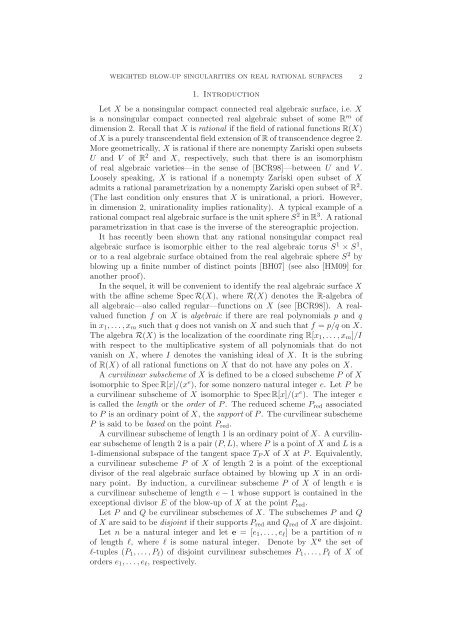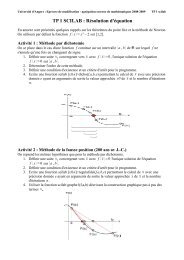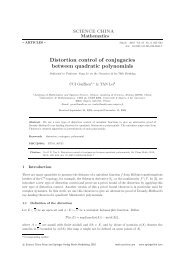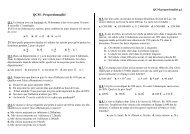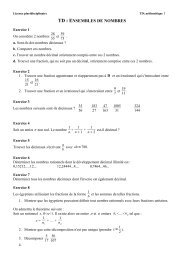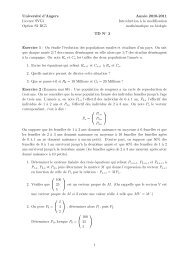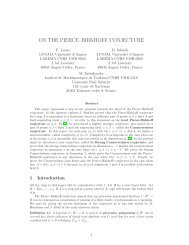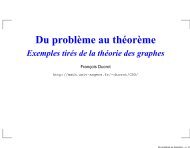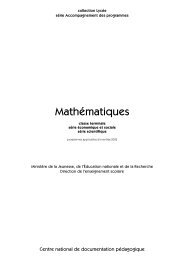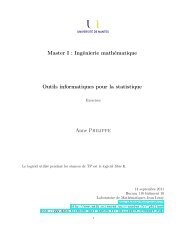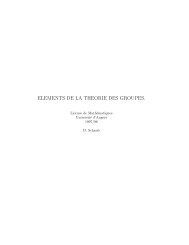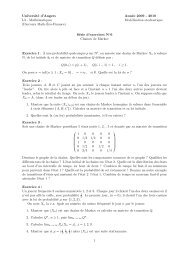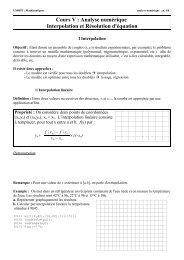automorphisms of real rational surfaces and weighted blow-up ...
automorphisms of real rational surfaces and weighted blow-up ...
automorphisms of real rational surfaces and weighted blow-up ...
Create successful ePaper yourself
Turn your PDF publications into a flip-book with our unique Google optimized e-Paper software.
WEIGHTED BLOW-UP SINGULARITIES ON REAL RATIONAL SURFACES 2<br />
1. Introduction<br />
Let X be a nonsingular compact connected <strong>real</strong> algebraic surface, i.e. X<br />
is a nonsingular compact connected <strong>real</strong> algebraic subset <strong>of</strong> some R m <strong>of</strong><br />
dimension 2. Recall that X is <strong>rational</strong> if the field <strong>of</strong> <strong>rational</strong> functions R(X)<br />
<strong>of</strong> X is a purely transcendental field extension <strong>of</strong> R <strong>of</strong> transcendence degree 2.<br />
More geometrically, X is <strong>rational</strong> if there are nonempty Zariski open subsets<br />
U <strong>and</strong> V <strong>of</strong> R 2 <strong>and</strong> X, respectively, such that there is an isomorphism<br />
<strong>of</strong> <strong>real</strong> algebraic varieties—in the sense <strong>of</strong> [BCR98]—between U <strong>and</strong> V .<br />
Loosely speaking, X is <strong>rational</strong> if a nonempty Zariski open subset <strong>of</strong> X<br />
admits a <strong>rational</strong> parametrization by a nonempty Zariski open subset <strong>of</strong> R 2 .<br />
(The last condition only ensures that X is uni<strong>rational</strong>, a priori. However,<br />
in dimension 2, uni<strong>rational</strong>ity implies <strong>rational</strong>ity). A typical example <strong>of</strong> a<br />
<strong>rational</strong> compact <strong>real</strong> algebraic surface is the unit sphere S 2 in R 3 . A <strong>rational</strong><br />
parametrization in that case is the inverse <strong>of</strong> the stereographic projection.<br />
It has recently been shown that any <strong>rational</strong> nonsingular compact <strong>real</strong><br />
algebraic surface is isomorphic either to the <strong>real</strong> algebraic torus S 1 × S 1 ,<br />
or to a <strong>real</strong> algebraic surface obtained from the <strong>real</strong> algebraic sphere S 2 by<br />
<strong>blow</strong>ing <strong>up</strong> a finite number <strong>of</strong> distinct points [BH07] (see also [HM09] for<br />
another pro<strong>of</strong>).<br />
In the sequel, it will be convenient to identify the <strong>real</strong> algebraic surface X<br />
with the affine scheme Spec R(X), where R(X) denotes the R-algebra <strong>of</strong><br />
all algebraic—also called regular—functions on X (see [BCR98]). A <strong>real</strong>valued<br />
function f on X is algebraic if there are <strong>real</strong> polynomials p <strong>and</strong> q<br />
in x1,... ,xm such that q does not vanish on X <strong>and</strong> such that f = p/q on X.<br />
The algebra R(X) is the localization <strong>of</strong> the coordinate ring R[x1,... ,xm]/I<br />
with respect to the multiplicative system <strong>of</strong> all polynomials that do not<br />
vanish on X, where I denotes the vanishing ideal <strong>of</strong> X. It is the subring<br />
<strong>of</strong> R(X) <strong>of</strong> all <strong>rational</strong> functions on X that do not have any poles on X.<br />
A curvilinear subscheme <strong>of</strong> X is defined to be a closed subscheme P <strong>of</strong> X<br />
isomorphic to Spec R[x]/(x e ), for some nonzero natural integer e. Let P be<br />
a curvilinear subscheme <strong>of</strong> X isomorphic to SpecR[x]/(x e ). The integer e<br />
is called the length or the order <strong>of</strong> P. The reduced scheme Pred associated<br />
to P is an ordinary point <strong>of</strong> X, the s<strong>up</strong>port <strong>of</strong> P. The curvilinear subscheme<br />
P is said to be based on the point Pred.<br />
A curvilinear subscheme <strong>of</strong> length 1 is an ordinary point <strong>of</strong> X. A curvilinear<br />
subscheme <strong>of</strong> length 2 is a pair (P,L), where P is a point <strong>of</strong> X <strong>and</strong> L is a<br />
1-dimensional subspace <strong>of</strong> the tangent space TPX <strong>of</strong> X at P. Equivalently,<br />
a curvilinear subscheme P <strong>of</strong> X <strong>of</strong> length 2 is a point <strong>of</strong> the exceptional<br />
divisor <strong>of</strong> the <strong>real</strong> algebraic surface obtained by <strong>blow</strong>ing <strong>up</strong> X in an ordinary<br />
point. By induction, a curvilinear subscheme P <strong>of</strong> X <strong>of</strong> length e is<br />
a curvilinear subscheme <strong>of</strong> length e − 1 whose s<strong>up</strong>port is contained in the<br />
exceptional divisor E <strong>of</strong> the <strong>blow</strong>-<strong>up</strong> <strong>of</strong> X at the point Pred.<br />
Let P <strong>and</strong> Q be curvilinear subschemes <strong>of</strong> X. The subschemes P <strong>and</strong> Q<br />
<strong>of</strong> X are said to be disjoint if their s<strong>up</strong>ports Pred <strong>and</strong> Qred <strong>of</strong> X are disjoint.<br />
Let n be a natural integer <strong>and</strong> let e = [e1,... ,eℓ] be a partition <strong>of</strong> n<br />
<strong>of</strong> length ℓ, where ℓ is some natural integer. Denote by X e the set <strong>of</strong><br />
ℓ-t<strong>up</strong>les (P1,... ,Pℓ) <strong>of</strong> disjoint curvilinear subschemes P1,... ,Pℓ <strong>of</strong> X <strong>of</strong><br />
orders e1,... ,eℓ, respectively.


